1. 基本概念
1.1 功能
- 将数据进行链式存储
1.2 概念
- list是一种物理存储单元上非连续的存储结构,数据元素的逻辑顺序是通过链表中的指针链接实现的。STL中的链表是一个双向循环链表。
1.3 组成和存储方式
- 链表的组成:链表由一系列结点组成
- 结点的组成:是一个储存元素的数据域,另一个存储下一个结点地址的指针域。
- 链表的存储方式并不是连续的内存空间,因此链表list中的迭代器只支持前移和后移,属于双向迭代器。
1.4 优缺点
- 优点:
- 采用动态存储分配,不会造成内存的浪费和溢出
- 方便插入和删除,直接修改指针即可,不需移动大量元素
- 插入删除都不会造成原有list迭代器失效,这在vector是不成立的。
- 缺点:
- 链表灵活,但空间(指针域)和时间(遍历)额外耗费较大
1.4 图解
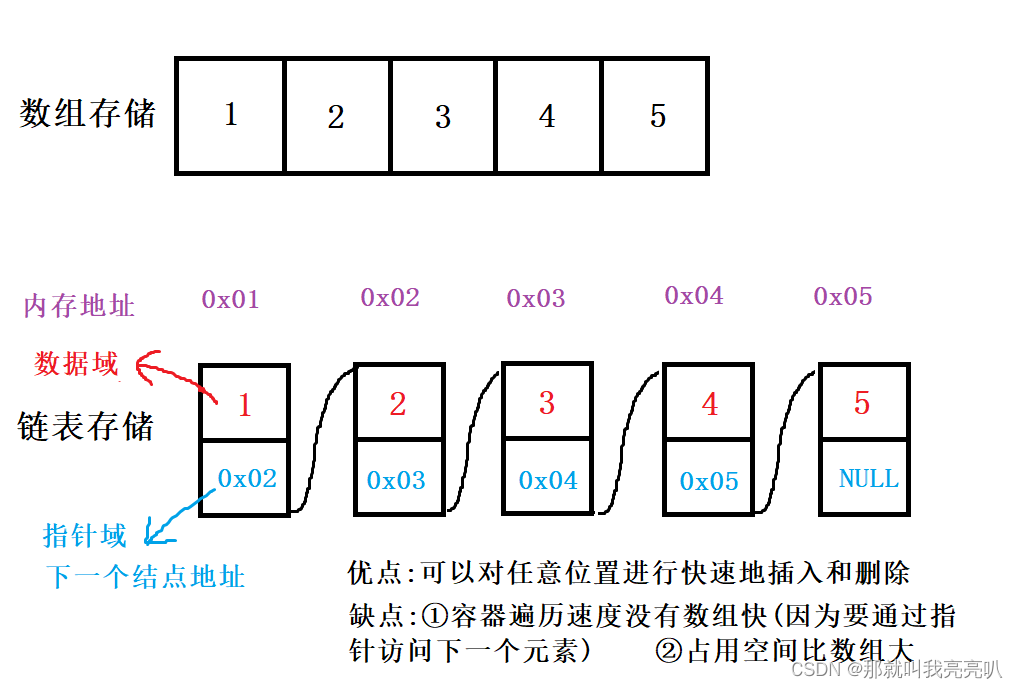
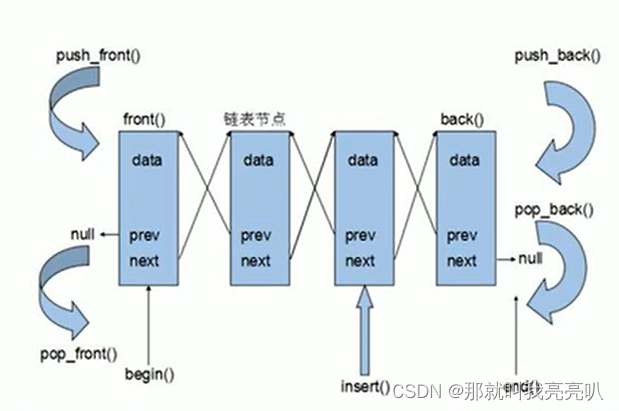
2. 构造函数
2.1 函数原型
list<T> lstlist采用模板类实现,对象的默认构造形式list(beg,end);构造函数将[beg,end)区间中的元素拷贝给本身list(n,elem);构造函数将n个elem拷贝给本身list(const list &lst);拷贝构造函数
2.2 代码展示
#include<stdio.h>
#include<iostream>
#include<list>
using namespace std;
void printList(const list<int> l) {
for (list<int> ::const_iterator it = l.begin(); it != l.end(); it++) {
cout << (*it) << " ";
}
cout << endl;
cout << "-----------------------------------------------" << endl;
}
void text01() {
//①默认构造
list<int> l1;
l1.push_back(10);
l1.push_back(20);
l1.push_back(30);
l1.push_back(40);
l1.push_back(50);
printList(l1);
//②区间方式构造
list<int> l2(++l1.begin(), --l1.end());
printList(l2);
//③拷贝构造
list<int> l3 = l2;
printList(l3);
//④n个elem
list<int> l4(10, 5);
printList(l4);
}
int main() {
text01();
return 0;
}
2.3 测试结果
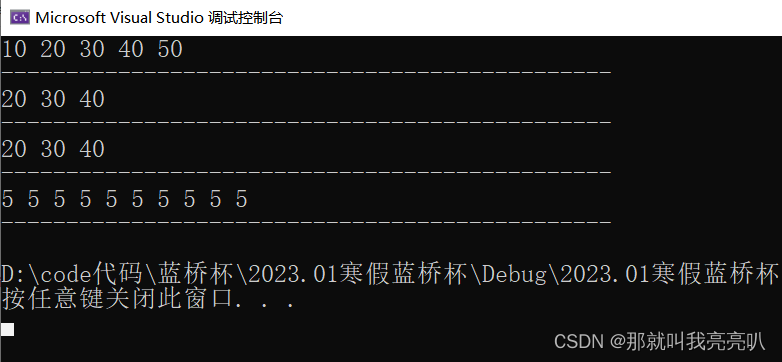
3. 赋值交换
3.1 函数原型
assign(beg,end);将[beg, end)区间中的数据拷贝给assign(n, elem);将n个elem拷贝赋值给本身list& opreator=(const list &lst);重载等号操作符swap(lst)将lst与本身的元素互换
3.2 代码展示
#include<stdio.h>
#include<iostream>
#include<list>
using namespace std;
void printList(const list<int> l) {
for (list<int> ::const_iterator it = l.begin(); it != l.end(); it++) {
cout << (*it) << " ";
}
cout << endl;
cout << "-----------------------------------------------" << endl;
}
void printList2(const list<int> l) {
for (list<int> ::const_iterator it = l.begin(); it != l.end(); it++) {
cout << (*it) << " ";
}
cout << endl;
}
void text02() {
list<int> lst1;
lst1.push_back(10);
lst1.push_back(20);
lst1.push_back(30);
lst1.push_back(40);
lst1.push_back(50);
printList(lst1);
//=赋值
list<int> lst2(lst1);
printList(lst2);
//assign赋值
list<int> lst3;
lst3.assign(++lst2.begin() , lst2.end());
printList(lst3);
//n个ele赋值
list<int> lst4;
lst4.assign(10, 3);
printList(lst4);
cout << endl;
//交换容器
cout << "lst3="; printList2(lst3);
cout << "lst4="; printList2(lst4);
swap(lst3, lst4);
cout << "lst3="; printList2(lst3);
cout << "lst4="; printList2(lst4);
}
int main() {
text02();
return 0;
}
3.3 测试结果
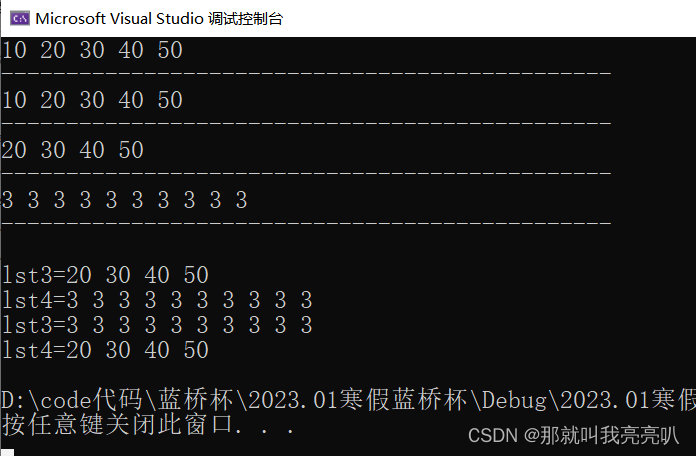
4. 大小操作
empty();判断容器是否为空size();返回容器元素的个数resize(num);重新指定元素的长度为num,若容器变长,则用默认值重新填充位置;若变短,则末尾超出容器长度的元素被删除。resize(num, elem);重新指定元素的长度为num,若容器变长,则用elem重新填充位置;若变短,则末尾超出容器长度的元素被删除。
1.3 代码展示
#include<stdio.h>
#include<iostream>
#include<list>
using namespace std;
void printList(const list<int> l) {
for (list<int> ::const_iterator it = l.begin(); it != l.end(); it++) {
cout << (*it) << " ";
}
cout << endl;
cout << "-----------------------------------------------" << endl;
}
void text03() {
list<int> l;
l.push_back(10);
l.push_back(20);
l.push_back(30);
l.push_back(40);
l.push_back(50);
//判空
if (l.empty()) cout << "容器为空" << endl;
else cout << "容器不为空" << endl;
//容器大小
cout << "容器大小为:" << l.size() << endl;
//重新指定大小
l.resize(10);
printList(l);
l.resize(4);
printList(l);
//重载重新指定大小
l.resize(10, 5);
printList(l);
}
int main() {
text03();
return 0;
}
1.4 测试结果

6. 插入删除
6.1 函数原型
push_back();尾插pop_back();尾删push_front(elem);在容器开头插入一个元素pop_front(elem);在容器开头移除第一个元素insert(pos, elem);在pos位置插入elem元素,返回新数据的位置insert(pos, n ,elem);在pos位置插入n个elem数据,无返回值insert(pos, beg, end);在pos位置插入[beg, end)区间的数据,无返回值clear();移除容器的所有数据erase(beg, end);删除[beg, end)区间的数据,返回下一个数据的位置erase(pos);删除pos位置的数据,返回下一个数据的位置remove(elem);删除容器中所有与elem匹配的元素
6.2 代码展示
#include<stdio.h>
#include<iostream>
#include<list>
using namespace std;
void printList(const list<int> l) {
for (list<int> ::const_iterator it = l.begin(); it != l.end(); it++) {
cout << (*it) << " ";
}
cout << endl;
cout << "-----------------------------------------------" << endl;
}
void text04() {
list<int> l1;
//尾插
l1.push_back(10);
l1.push_back(20);
l1.push_back(30);
printList(l1);
//头插
l1.push_front(300);
l1.push_front(200);
l1.push_front(100);
printList(l1);
//尾删
l1.pop_back();
printList(l1);
//头删
l1.pop_front();
printList(l1);
//insert插入
l1.insert(l1.begin(), 8);
printList(l1);
//insert重载
l1.insert(++l1.begin(), 1, 9);
printList(l1);
list<int>::iterator it = l1.begin();
//删除
it = l1.begin();
l1.erase(++it);
printList(l1);
//匹配上的全部移除
l1.push_back(10000);
l1.push_back(10000);
printList(l1);
l1.remove(10000);
printList(l1);
//清空
l1.clear();
printList(l1);
}
int main() {
text04();
return 0;
}
6.3 测试结果
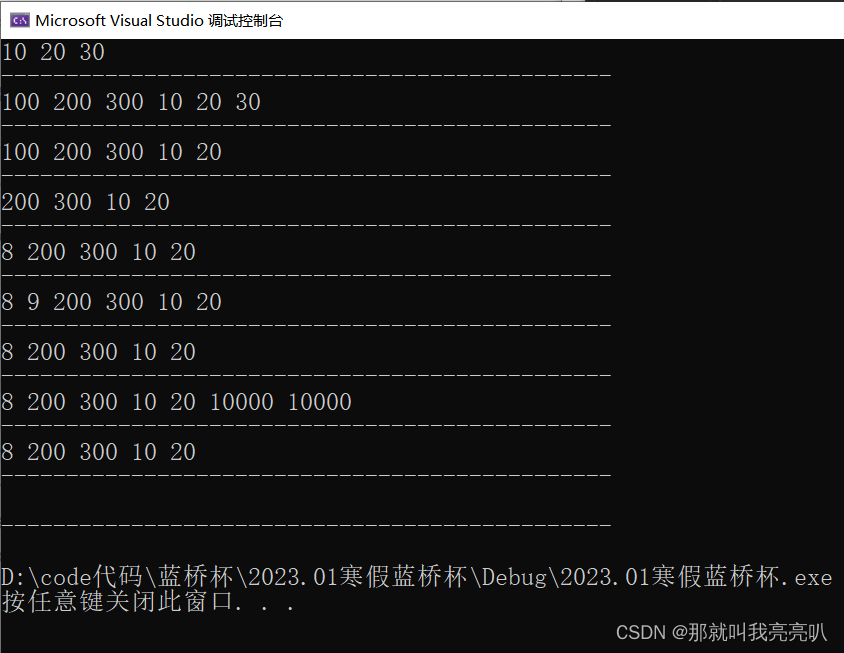
7. 数据存取
7.1 函数原型
front();返回第一个元素back();返回最后一个元素
7.2 代码展示
#include<stdio.h>
#include<iostream>
#include<list>
using namespace std;
void text05() {
list<int> l1;
l1.push_back(10);
l1.push_back(20);
l1.push_back(30);
l1.push_back(40);
l1.push_back(50);
cout << l1.front() << endl;
cout << l1.back() << endl;
list<int> ::iterator it = l1.begin();
//链表不是用线性空间的存储数据,迭代器不能随机访问。
it++; it--; //支持双向
//it += 1; 报错 ==> 不支持随机访问
}
int main() {
text05();
return 0;
}
7.3 测试结果
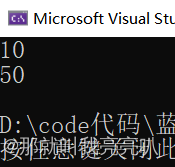
8. 反转排序
8.1 函数原型
reverse();反转sort();排序
8.2 代码展示
#include<algorithm>
bool cmp(int t1, int t2) {
return t1 > t2;
}
void text06() {
list<int> l1;
l1.push_back(10);
l1.push_back(2);
l1.push_back(300);
l1.push_back(50);
l1.push_back(150);
cout << "反转前:"; printList(l1);
//反转
l1.reverse();
cout << "反转后:"; printList(l1);
//排序
//sort(l1.begin(), l1.end());
//不支持随机访问迭代器的容器,内部会提供一些算法
l1.sort();
cout << "小->大排序后:"; printList(l1);
l1.sort(cmp);
cout << "大->小排序后:"; printList(l1);
}
int main() {
text06();
return 0;
}
8.3 测试结果
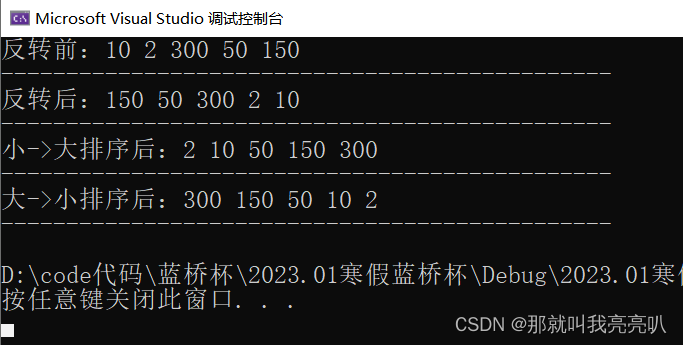
9. 自定义数据类型排序案例
9.1 题目
- 案例描述:将Player自定义数据类型进行排序,Person中属性有姓名、年龄、得分。
- 排序规则:按照年龄进行升序,如果年龄相同按照得分进行降序
9.2 代码展示
#include<stdio.h>
#include<iostream>
#include<string>
#include<algorithm>
#include<list>
using namespace std;
class Player {
public:
Player(string name, int age, int score) {
this->m_name = name;
this->m_age = age;
this->m_score = score;
}
public:
string m_name;
int m_age;
int m_score;
};
bool cmp(Player &p1, Player &p2) {
if (p1.m_age != p2.m_age) return p1.m_age < p2.m_age;
else return p1.m_score > p2.m_score;
}
void printList(const list<Player>& l) {
for (list<Player>::const_iterator it = l.begin(); it != l.end(); it++) {
cout << (*it).m_name << " " << (*it).m_age << " " << (*it).m_score << endl;
}
cout << endl;
}
void text01() {
//创建容器
list<Player> l1;
//定义数据
Player p1("James", 38, 4000);
Player p2("Curry", 34, 3000);
Player p3("Irving", 30, 3500);
Player p4("Harden", 36, 3300);
Player p5("Durant", 34, 3800);
//插入数据
l1.push_back(p1);
l1.push_back(p2);
l1.push_back(p3);
l1.push_back(p4);
l1.push_back(p5);
//打印输出
printList(l1);
//排序
l1.sort(cmp);
//打印输出
printList(l1);
}
int main() {
text01();
return 0;
}
9.3 测试结果
